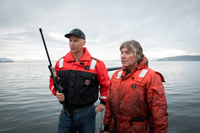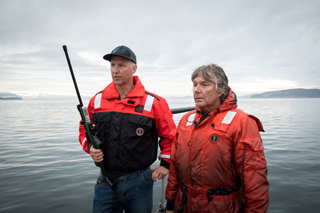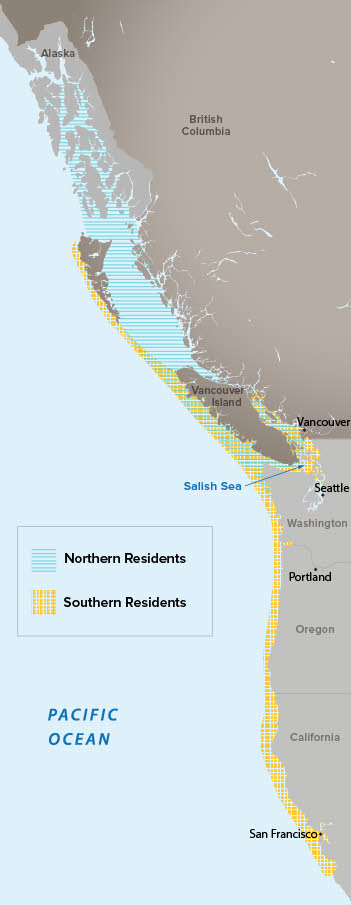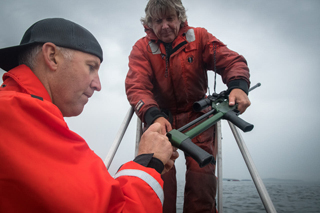

Photo by Katy Foster/National Oceanic and Atmospheric Administration (NOAA) Fisheries, under permit 18786-03
Dr. Joe Gaydos (left) of the SeaDoc Society near Seattle and Jeff Foster of the Whale Sanctuary Project prepared last August to administer antibiotics and antiparasitics via dart gun to an ailing killer whale named Scarlet.
As a boy, Dr. Joe Gaydos spent as much time as possible outdoors. "I was always the kid with frogs or snakes in my pocket," he said. Forty years later, not much has changed except now, Gaydos leaves the animals — from tiny candy stripe shrimp to 10,000-pound killer whales — where he found them.
Protecting nature is his charge as senior wildlife veterinarian and science director for the SeaDoc Society, a program dedicated to protecting the ecosystem of the Salish Sea. These coastal waterways off Seattle and Vancouver, B.C. are one of the more biodiverse temperate marine environments in the world, and are home to a beloved group of killer whales, or orcas, who are locked in a high-profile struggle for survival.
As a group, wildlife veterinarians comprise a small but growing specialty within the profession. In recent decades, wildlife management agencies and environmental organizations have been expanding the numbers of veterinarians on their teams. That shift has helped improve outcomes for endangered animals, expanded opportunities for veterinarians interested in working with wildlife, and pushed the frontier of veterinary intervention as a conservation strategy.
Gaydos recently sat down with the VIN News Service to talk about his career trajectory and last year's groundbreaking effort to turn the tide for local orcas.
Treating ecosystems
A tall man with a ready smile, Gaydos is an ideal ambassador for the Salish Sea, which is a big part of his job. He speaks fluent policymaker and schoolkid, and has written books for both audiences. He stars in documentary shorts, oversees the research of others and conducts his own, including recent work on sea star wasting disease. He also uses his hands-on skills with animals, including helping to free sea lions entangled in plastic packing strips.
Talking about his work, Gaydos is generous with superlatives: Anemones are "beautiful"; sand lance fish are "awesome"; Pacific spiny lumpsuckers, his favorite, are "cool."
Whale map

Map by Tamara Rees. Source: NOAA
Killer whales, or orcas, are found in every ocean in the world. Two populations of salmon-eating killer whales, known as southern and northern residents, live off the U.S. coast from Northern California to southern Alaska. The critically endangered southern residents spend much of the year in the Salish Sea. Two other groups, marine-mammal eaters known as transients; and offshore whales that specialize in eating sharks, also live in the area. In addition, Alaska has three resident populations of its own.
Gaydos always hoped to combine his interest in medicine (passed down by his parents, a physician and a medical researcher) and wildlife work. With patience and persistence, he did. After graduating from University of Pennsylvania School of Veterinary Medicine in 1994, he took a year-long stint at the Philadelphia Zoo. When he couldn't find a similar position, he went into mixed animal practice in West Virginia.
"Back then, there just weren't that many jobs working with wildlife," he said. Eventually, he returned to school and earned a PhD in medical microbiology from the University of Georgia College of Veterinary Medicine, while moonlighting as a house-call veterinarian. He also studied viruses in deer at UGA's Southeastern Cooperative Wildlife Disease Study, which investigates outbreaks and provides support for management agencies in 18 states. It is one of a handful of major wildlife medicine programs at veterinary schools.
By the time he finished his doctorate in 2001, opportunities for wildlife veterinarians were starting to pop up. He applied for a posting on a listserv, and landed the gig at the fledgling SeaDoc Society — all the way across the country and focusing on a marine environment he knew almost nothing about.
"I was drinking from the firehose when I started," he said. "But it was so fun."
Gaydos is the only staff veterinarian at SeaDoc headquarters on Orcas Island in Puget Sound near Seattle. His team includes other scientists and a communications and support team. He frequently partners with veterinarians at other agencies or organizations in the U.S. and Canada. During summers, SeaDoc runs an internship program for third-year veterinary students.
The SeaDoc Society — a program of the Karen C. Drayer Wildlife Health Center (WHC) at the University of California, Davis, School of Veterinary Medicine — was spearheaded and initially funded by a pair of Orcas Island residents looking to help the marine ecosystem of Puget Sound and the Northwest Straits. Its mission is to sponsor and conduct peer-reviewed science, and to make sure that science gets into the hands of decision-makers including legislators, wildlife managers and the public.
WHC is a multidisciplinary research, service and teaching center within the school's One Health Institute. It operates a variety of programs around the world to advance the health of wildlife in balance with people and the environment.
Pursuing a One Health ethos before it had that name, Gaydos puts it simply, "We're all better off when we're all better off. "
The reverse is equally true, and the struggles of the Salish Sea's iconic killer whales are an indicator that things are amiss for many inhabitants of their ecosystem.
Worldwide, killer whales are not endangered but the pods that are local to the Salish Sea are suffering and at risk of extinction. Belonging to one of three regional ecotypes, the term for species groups distinguished by dietary habits and residency patterns, the southern resident killer whales eat fish, typically salmon, and generally remain in the Salish Sea spring through fall. (Northern residents also are fish-eaters but stick close to the waters off Canada.)
The plight of southern residents reveals system-wide problems: Their decline is tied to scarcity of their preferred food, Chinook salmon, due to habitat degradation and overfishing. Vessel noise, which interferes with orca communication during hunting and prey sharing, and toxicants in the water are other culprits.
While orcas are central to the region's identity — they adorn mugs, T-shirts, and even transit fare cards go by the acronym ORCA — killer whales weren't the SeaDoc Society's original focus. Dr. Kirsten Gilardi, WHC co-director, explained SeaDoc's perspective: "Early on we wanted to fill gaps. We thought our niche would be to address problems that fell outside the purview of existing agencies."
At the time, there were many great organizations focused on killer whales. There still are. But the situation for this group of whales is so dire, SeaDoc has joined the effort to preserve them, Gilardi explained.
Is the world ready for wild-whale veterinarians?
Courtesy NOAA Fisheries, filmed under NMFS research permit 21368
Video shows southern resident killer whale J50 swimming close to her mother on Puget Sound, near Seattle, Aug. 9, 2018. Researchers from the National Oceanic and Atmospheric Administration (NOAA) and Fisheries and Oceans Canada prepare to capture a breath sample and administer an antibiotic injection.
There are 75 southern residents. This count is down from a high, since tracking began four decades ago, of 98 counted in 1995. Last year, researchers watched with concern as a young orca called Scarlet, or more prosaically J50, lost weight, lagged behind her family, and failed to join in foraging and prey sharing. These signs were worrisome for J50 and, as a young female with many reproductive years ahead, a potentially serious setback for the survival of her kin. Her poor condition pushed biologists and veterinarians on a multiagency, cross-border team to take unprecedented action.
"Over the last few years, we've had a lot of animals die," Gaydos said. "I think we were just feeling like, are we ready to just sit by and do nothing again, or can we start talking about what we might be able to do?"
The idea that veterinarians can help wild animals is not revolutionary. They have long treated injured animals and assisted during wildlife studies and relocations. But an ongoing effort to minister to a population in the wild is rare and controversial.
"It was heresy for a lot of people to think about treating a wild animal," Gaydos said. Concerns include interfering with natural processes or doing damage in the name of doing good. In the case of whales, for example, anything that puts boats close to the animals can be detrimental.
"We're veterinarians, part of our oath is ‘Do no harm,'" Gaydos said. "We take that for real. We're not going to do anything unless we feel like we have a greater chance of helping."
To be clear, Gaydos is not suggesting veterinary treatment is a cure or that it can reverse current trends. Instead, he believes it can be an important component of an ongoing ecosystem-wide recovery effort that includes bolstering the number of coastal salmon; reducing marine traffic and noise; and cutting down on contaminants in the water.
On the other side of the world, there is evidence veterinarians can make a positive impact on wild populations. In East Central Africa, an international team of veterinarians provide hands-on life-saving veterinary care to critically endangered wild mountain and eastern lowland gorillas who are sick or injured. For more than three decades, Gorilla Doctors have been removing snares, treating respiratory disease, and even at one point in time vaccinating gorillas against viruses transmitted by humans. Today, these gorillas comprise the only rebounding populations of great apes in the world. Nearly half of their annual growth rate of 4 percent can be attributed to veterinary care, according to a 2011 paper.
The brainchild of famed primatologist and conservationist Dian Fossey, Gorilla Doctors operates via a partnership of WHC and the Mountain Gorilla Veterinary Project.
Making a diagnosis with drones, dogs and surfboard masts
Understanding what ailed J50 was the first step in treating her, but making a diagnosis in the case of a free-roaming whale that travels with others isn't simple.
The process began with what was generally known from field observation, lessons from experts working with captive animals, and necropsies.
In the early 2000s, Gaydos co-developed a foundational killer-whale necropsy protocol with Dr. Stephen Raverty, a veterinary pathologist in British Columbia, and Dr. Judy St. Leger, a veterinary pathologist with Sea World. That work, along with funding, greatly increased the number of stranded whale cadavers that are examined, yielding valuable information, including the fact that many of the dead whales examined carried high loads of manmade toxicants and had had bacterial pneumonia.
Based on the latter fact, the team decided to try to administer a broad-spectrum, long-acting antibiotic to J50.
Additional tools for diagnosing the whale were as unusual as the circumstances. The team used measurements from aerial drone photography, known as photogrammetry, to confirm emaciation and, later on, to calculate doses for medications based on estimated body weight.
Blowhole samples were used as a noninvasive alternative to a blood draw. A biologist in a cage at the prow of a skiff extended an 18-foot surfboard mast with a petri dish attached to the end over the swimming whale to capture the vapor from J50's blowhole when she surfaced.
"The lungs are a cool place because there is a very small interface between blood and air," Gaydos said. "You can look at bacteria, you can look at proteins, things like that. "
Recent research has demonstrated that blowhole samples can be cultured and yield diagnostic information. However, in J50's case, the culture was inconclusive.
Another biologist on the team hit the water with a scat-detection dog trained to find and lead researchers to whale feces floating on the surface. Two samples were collected, and DNA analysis identified one as belonging to J50's mother. It revealed common parasites. Because these whales share prey, the researchers inferred that J50 had the same parasites as her mother.
While Gaydos and others didn't think parasites were J50's main problem, they considered it an added stressor. They decided that if they could treat the parasites, they might relieve some pressure on J50's immune system to help her fight whatever else was bringing her down.
With diagnosis well underway in late July, a 20-year-old killer whale in J50's pod — J35, also known as Tahlequah — was spotted pushing a dead calf with her head. Her baby, also a female, had died within an hour of being born. J35 ended up keeping her calf afloat for 17 days. On the internet, she became on international obsession. Researchers described the episode as the longest recorded example of mourning behavior.
Despite the ordeal, the bereft mother seemed to be in fine physical condition when it was over. However, the death of a female calf was another blow to the pod's survival, and a spur to efforts for J50.
Drs. Gaydos and Haulena

Photo by Katy Foster/NOAA Fisheries, under permit 18786-03
Gaydos and Foster loaded medications into a dart gun during last summer's efforts to treat an ailing orca.
Over two months, Gaydos, working with Dr. Martin Haulena, a veterinarian with the Vancouver Aquarium, and researchers from NOAA Fisheries and Fisheries and Oceans Canada attempted to get antibiotics and antiparasitics into J50 via dart guns. At the same time, biologists from the Whale Sanctuary Project and Lummi Indian Nation tested a feeding trial to see if they might be able to use live salmon to medicate J50. Ultimately, these efforts were unsuccessful.
A few days after the last darting run in early September, J50 was spotted for the last time. She is considered dead. Unless they beach, the bodies of dead whales are almost never recovered.
That was tough, Gaydos acknowledged. "You totally get involved. You see this whale, and she's amazing," he said, noting that despite her weight loss J50 seemed to have a strong will to live. "When she dies, you're so let down. You think: ‘I didn't do enough. '" We want to be able to do more.”
The next steps for the veterinary intervention model will be both proactive and reactive. Noninvasive diagnostic tools need improving, Gaydos said. For example, more work is needed to identify what to test for in blowhole samples and to create deployment models that don't require bringing a boat in close to a whale. Authors of a study involving endangered North Atlantic right whales suggested that maybe drones could gather the samples.
The team also continues to refine protocols for intervention, but as for the question of whether to intervene at all, a critical boundary has been crossed. "Next time, we won't spend time thinking yes or no," Gilardi said. "J50 broke the ice on that."
Editor's note: The captions on the NOAA photos have been changed to properly identify the individual working beside Dr. Joe Gaydos.